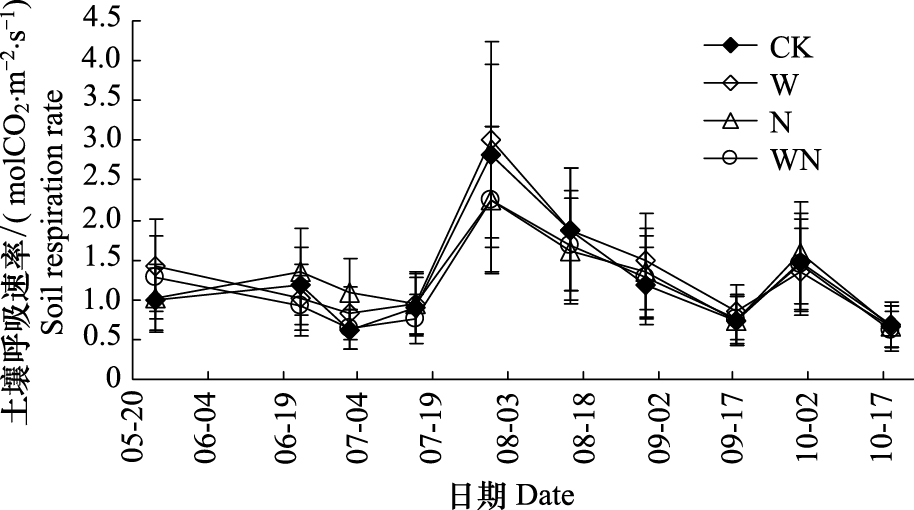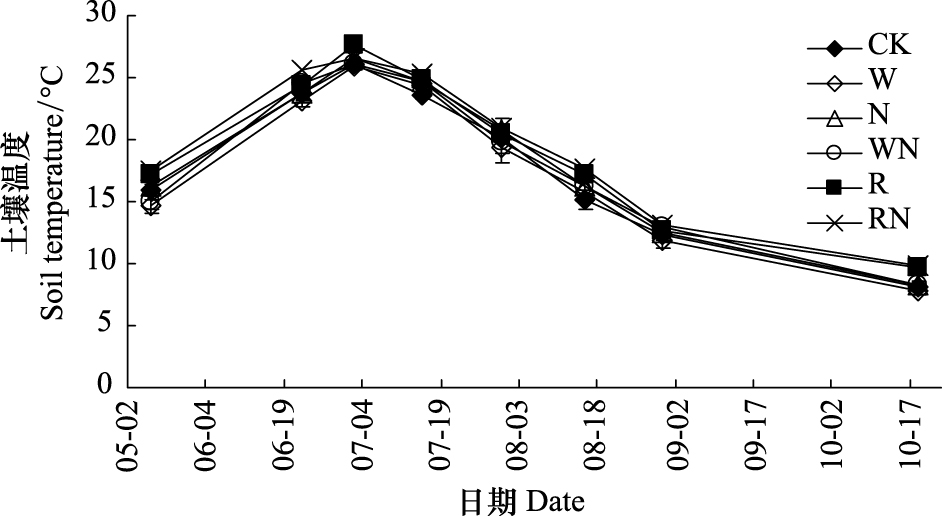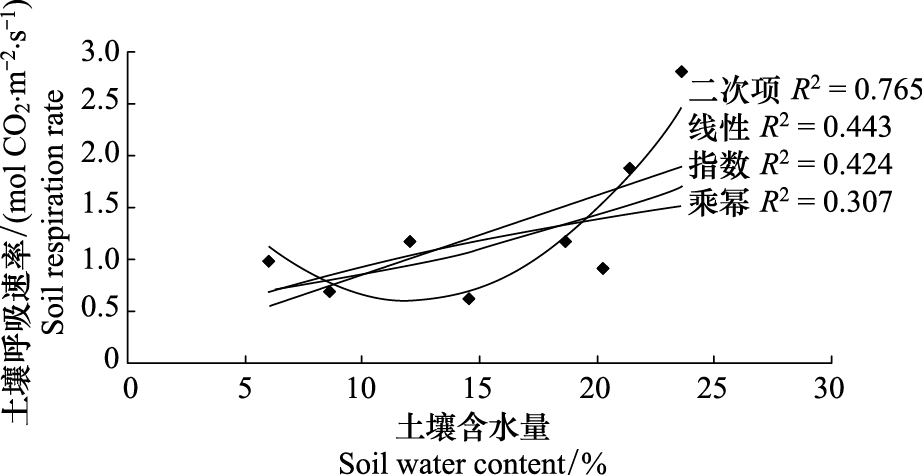文章信息
- 李寅龙, 红梅, 白文明, 韩国栋, 王海明, 周萌
- LI Yinlong, HONG Mei, BAI Wenming, HAN Guodong, WANG Haiming, ZHOU Meng
- 水、氮控制对短花针茅草原土壤呼吸的影响
- The responses of soil respiration to water and nitrogen in Stipa breviflora steppe
- 生态学报, 2015, 35(6): 1727-1733
- Acta Ecologica Sinica, 2015, 35(6): 1727-1733
- http://dx.doi.org/10.5846/stxb201305301231
-
文章历史
- 收稿日期:2013-05-30
- 修订日期:2014-04-25
2. 中国科学院植物研究所, 北京 100093;
3. 内蒙古农牧科学院, 呼和浩特 010031;
4. 中国科学院大学, 北京 100049
2. Institute of Botany, the Chinese Academy of Scinces, Beijing 100093, China;
3. Inner Mongolia Academy of agricultural & animal husbandry science, Hohhot 010031, China;
4. University of Chinese Academy of Sciences, Beijing 100049, China
土壤碳库容量巨大,每年因土壤呼吸向大气释放的碳量高达68×1015 g[1, 2]。而土壤呼吸做为土壤碳库输出的重要环节,是土壤与大气交换CO2的过程,土壤吸收CO2的速率远小于排放CO2的速率,所以一般情况下,土壤呼吸就是土壤净排放的CO2[3]。因此对作为全球碳循环关键生态过程的土壤呼吸进行定量研究,具有十分重要的科学意义。
随着对气候变化日趋关注,人们对土壤呼吸及其主要影响因素进行了大量研究。目前,在草地生态系统中温度对土壤呼吸影响研究较为深入[4],而土壤水分含量和其他因素对土壤呼吸的影响研究相对较少。土壤水分对土壤呼吸的影响主要由土壤含水量在田间持水量的上下线决定[5]。Lavigne MB[6]在冷杉系统研究得出,当土壤含水量在田间持水量以下时,土壤呼吸速率随土壤含水量的增加而加快;Davidson EA[7]在森林和放牧地研究得出,当土壤含水量在田间持水量以上时,土壤呼吸速率随土壤含水量的增加而减慢。以上研究是在水分含量相对大的生态系统得出的结论,但作为干旱区典型生态系统的短花针茅草原是怎么影响的,报道依然是较少。氮元素对植物生长起到关键作用,而氮输入对土壤呼吸的影响主要集中在农田生态系统中。研究结果显示,在农田生态系统中,氮素添加可单独解释8%的土壤呼吸变异[8]。氮素添加对土壤呼吸的影响表现3种不同结果,促进作用[9],抑制作用[10],无显著影响[11]。而对草原土壤是怎么样的影响报道较少。所以我们考虑了降雨量和氮输入作为控制因子对短花针茅草原土壤呼吸进行试验。以求进一步丰富研究区域。
短花针茅草原作为亚洲特有的一种草原类型,是最干旱的草原类型,生态环境异常严酷,系统极度脆弱,稳定性差,在自然和人为干扰下极易退化。短花针茅草原作为荒漠草原的典型代表,在草原生态系统中有着极特殊的位置。本文以短花针茅(Stipa breviflora)草原为研究对象,通过控制降雨量以及氮素添加对土壤呼吸和土壤含水量动态进行监测,研究土壤呼吸速率对土壤含水量和氮素添加的响应过程,揭示降雨量和氮素添加对土壤呼吸速率的影响作用。比较不同降雨量和氮素添加对短花针茅草原土壤呼吸速率影响的差异,为短花针茅草原生态系统的合理利用提供基础数据。
1 研究区概况试验地位于内蒙古自治区乌兰察布市四子王旗王府一队,内蒙古农牧科学院试验基地内,属大陆性温带半干旱气候,多年的平均降雨量248 mm,年均蒸发量2947 mm,湿润度为0.15—0.30,降水量主要集中在6—9月,占全年降水总量的70%以上;试验区全年主要风向为北风和西北风,大风天数占全年的54%—66%。试验地区的土壤具有高钾、低磷和少氮的特点,土壤有机碳含量为14 g/kg,全氮含量为1.6 g/kg。土壤较瘠薄,腐殖质层厚20—30 cm,钙积层分布在20—30 cm,样地为短花针茅(Stipa breviflora)为建群种的荒漠草原地带性植被,草地类型为短花针茅(Stipa breviflora)+冷蒿(Artemisia frigida)+无芒隐子草(Cleistogenes Keng),植被高度低矮,植被较稀疏,平均高度为8 cm,盖度为17%—20%,植物种类组成贫乏,样地内植物群落主要由20多种植物物种组成。
2 试验处理与方法 2.1 试验处理水分和氮素二因素交互试验2010年8月,采用了裂区设计,6种处理(对照-CK、增雨-W、减雨-R、施氮-N、增雨施氮-WN、减雨施氮-RN),每种处理6次重复,共36个处理,随机区组排列。共有24个面积15 m × 9 m的小区,小区间隔2 m,12个减雨处理(R和RN处理各6个)是在其他处理的基础上增加减雨架,面积为3 m × 3 m。增雨减雨量为多年各月份平均降雨量的30%(58 mm)。增雨于每年的雨季(5—8月)的月初进行,使用喷洒装置进行模拟增雨,水滴均匀落在样地内,并保证不形成地表径流;减雨全年都在进行,使用自制的减雨架进行模拟减雨,减雨架遮挡面积为减雨小区面积的30%。氮素添加处理所施氮肥是NH4NO3(简称硝铵,NH4NO3,含氮33%—35%),施肥量为纯氮10 g/m2。在每年6月末或7月初雨季来临时进行喷施,以防止高温干旱的条件导致的NH4NO3挥发。施肥为一次施完。
2.2 试验方法土壤呼吸速率的测定采用开路式CO2通量测量系统,仪器型号为Li-8100(Li-COR,Lincoln,NE,USA)。2011年的5月底(植物返青)— 10中旬(植物枯落),分别于每月的中旬和下旬进行。日动态于植物生长旺盛期(7月2日,8月15日)进行。1次日动态以24 h为1周期,每间隔3 h测定1次土壤呼吸。土壤呼吸测定面积为直径为20 cm的样圆,在置放土壤呼吸罩之前,先将每一测定样点相应面积(20 cm直径)的地上绿色部分和枯落物齐地剪掉,同时把地表大型的土壤动物捡出。同时采用土钻野外取土,重量法测定0—10 cm土层的土壤含水量。10 cm土壤温度采用Li-8100自带温度探头测定。
本实验所有数据统计分析采用SAS9.0软件的ANOVA进行分析,当F检验显著时,进行各处理之间的分析。动态曲线采用Microsoft Excel 2003绘制。
3 结果与分析 3.1 不同降水量及氮素添加对土壤呼吸速率日变化的影响从7月2日和8月15日不同处理土壤呼吸速率日变化平均值(表 1),可以看出:不同时间各处理土壤呼吸速率的日变化有较大的差异。其中7月2日不同降雨量之间土壤呼吸速率差异显著,相同降雨量之间土壤呼吸速率差异不显著,尤其R和RN处理的土壤呼吸速率均值基本相同;相同降雨量氮素添加与不添加之间差异不显著,但单独N处理的均值明显高于其他处理。8月15日由于自然降雨增大,增雨处理与对照之间的差异不显著,减雨处理与增雨处理及对照之间差异显著。相同降雨量下,氮素添加与不添加土壤呼吸速率之间差异显著,都是氮素添加处理的土壤呼吸速率相对减小。
| 处理Treatment | 时间Time | ||
| 07-02 | 08-15 | ||
| 增雨施氮 Water addition and supplementary nitrogen | WN | 0.743±0.072Ba | 1.787±0.225Ab |
| 增雨 Water addition | W | 0.848±0.071Ba | 2.054±0.242Aa |
| 减雨施氮 Water reduction and supplementary nitrogen | RN | 0.524±0.043Ca | 1.010±0.143Bb |
| 减雨 Water reduction | R | 0.554±0.036Ca | 1.379±0.228Ba |
| 施氮 Supplementary nitrogen | N | 1.177±0.089Aa | 1.875±0.216Ab |
| 对照 Comparison | CK | 0.756±0.063Aa | 1.954±0.229Aa |
分析5—10月的土壤呼吸速率、土壤含水量和10 cm土壤温度测定值显示(图 1—图 3)。在整个试验期间,短花针茅草原土壤呼吸速率具有明显的季节变化,各处理的季节变化曲线基本一致,都呈规律的双峰波动曲线(图 1)。

|
| 图 1 不同水氮条件下土壤呼吸速率生育期动态变化 Fig. 1 Seasonal variation of soil respiration rate under different rainfall and nitrogen conditions CK:对照,W:增雨,R:减雨,N:施氮,WN:增雨施氮,RN:减雨施氮 |
图 1显示从5月末到7月初,CK、W、N和WN处理的土壤呼吸速率整体呈下降趋势。但是,在5月末到6月中旬CK、N和WN处理土壤呼吸速率有一个升高的过程,N的土壤呼吸速率相对较高,同时WN的土壤呼吸速率明显低于W;随后6月中旬至7月初,各处理的土壤呼吸速率有一个明显的降低过程。7月初到8月初,各处理的土壤呼吸速率迅速增大,并在8月初达到峰值,此时的土壤含水量达到最大值(图 2),10 cm土壤温度未达到最大值(图 3)。8月初到9月中旬,土壤呼吸速率开始降低,10月出现N处理的土壤呼吸速率比其它处理高的现象。从整个生长季来看,增雨处理下的氮素添加与不添加相比明显偏低。W处理显著增加土壤呼吸速率(P<0.05,表 2)。WN处理对增加土壤呼吸速率不显著(表 2)。

|
| 图 2 不同水氮条件下土壤含水量生育期动态变化 Fig. 2 Seasonal variation of soil water content under different rainfall and nitrogen conditions |

|
| 图 3 不同水氮条件下10cm土壤温度生育期动态变化 Fig. 3 Seasonal variation of soil temperature at 10 cm depth under different rainfall and nitrogen conditions |
|
处理 Treatment | 样本数 Measured soil respiration rate | 实测土壤呼吸速率 Measured soil respiration rate | R2 | P | |
| 增雨 Water addition | W | 8 | RS = 3.209 - 0.374WS + 0.014W2S | 0.727 | 0.039 |
| 增雨施氮 Water addition and supplementary nitrogen | WN | 8 | RS = 3.001 - 0.356WS + 0.014W2S | 0.636 | 0.08 |
| 减雨 Water reduction | R | 8 | RS = 1.365 - 0.147WS + 0.007W2S | 0.472 | 0.202 |
| 减雨施氮 Water reduction and supplementary nitrogen | RN | 8 | RS = 1.655 - 0.206WS + 0.009W2S | 0.495 | 0.181 |
| 施氮 Supplementary nitrogen | N | 8 | RS = 1.603 - 0.137WS + 0.007W2S | 0.567 | 0.123 |
| 对照 Comparison | CK | 8 | RS = 2.650 - 0.338WS + 0.014W2S | 0.765 | 0.027 |
| RS:土壤呼吸速率 Soil respiration rate,WS:土壤含水量 Soil water content | |||||
模拟干旱试验显示,R处理的土壤呼吸速率明显低于CK。R与RN处理相比,RN明显低于与R处理,从整个生长季来说N的土壤呼吸速率明显高于R和RN(图 4)。从表 3可知,氮素添加处理下,5月份RN处理差异显著,8月份R处理差异显著,其他月份各处理之间差异不显著。不添加氮素处理下,8月份R处理差异显著,其他月份各处理之间差异不显著。在刚施完氮之后的7月份R和RN处理之间差异显著(表 3)。表 2显示,整个生长季来看,R和RN处理差异都不显著。
| 月份Month | 增雨施氮WN | 减雨施氮RN | 施氮N | 增雨W | 减雨R | 对照CK | P |
| 5 | 1.29±0.09ab | 0.57±0.05d | 1.02±0.11bc | 1.43±0.16a | 0.55±0.09d | 0.91±0.12cd | 0.0001 |
| 6 | 0.93±0.09ab | 0.55±0.05b | 1.35±0.29a | 1.03±0.09ab | 0.93±0.09ab | 1.17±0.17a | 0.041 |
| 7 | 0.72±0.04b | 0.43±0.02c | 0.99±0.13a | 0.91±0.06ab | 0.69±0.08b | 0.81±0.10ab | 0.0006 |
| 8 | 2.06±0.18ab | 1.53±0.22b | 2.04±0.22ab | 2.63±0.22a | 1.66±0.20b | 2.50±0.27a | 0.008 |
| 9 | 1.02±0.09ab | 0.78±0.08b | 1.04±0.09ab | 1.17±0.13a | 0.91±0.09ab | 0.96±0.11a | 0.181 |
| 10 | 1.02±0.15a | 0.95±0.13a | 1.12±0.17a | 1.00±0.17a | 1.15±0.16a | 1.09±0.19a | 0.962 |
| 表中数据表示方法为Mean±SE;同一行不同字母为P<0.05时各处理之间的差异显著性 | |||||||

|
| 图 4 减雨和氮素添加下土壤呼吸速率的生育期动态变化 Fig. 4 Seasonal variation of soil respiration rate under less rainfall and nitrogen conditions |
极端降雨事件随全球气候变化越来越多,而降雨是土壤含水量最主要的来源。表层土壤含水量波动较大,与土壤呼吸速率之间的关系可能最密切。对样地土壤呼吸速率和土壤含水量实测数据采用线性,指数,一元二次方程进行回归分析,结果显示一元二次项方程拟合效果最佳(图 5—图 7),可解释土壤呼吸速率季节变化的47%—77%(表 2)。表 3显示,整个生长季W、CK处理达到显著(P<0.05),R处理对增加土壤呼吸速率不显著。

|
| 图 5 增雨处理土壤呼吸速率与土壤含水量的回归曲线 Fig. 5 Water addition treatment regression curves of soil respiration and soil moisture content |

|
| 图 6 减雨处理土壤呼吸速率与土壤含水量的回归曲线 Fig. 6 Water reduction treatment regression curves of soil respiration and soil moisture content |

|
| 图 7 对照处理土壤呼吸速率与土壤含水量的回归曲线 Fig. 7 Comparison treatment regression curves of soil respiration and soil moisture content |
土壤呼吸速率主要受土壤温度、土壤水分、pH、氮素含量和土壤质地等因素的影响。这些因素共同驱动土壤呼吸的日变化和季节变化。本文对短花针茅草原进行了控制性降雨和氮素添加试验。在5月末到6月中旬,随着气温升高,土壤呼吸速率增大,N处理增幅相对较大(图 1),这可能是土壤含水量相对较低,氮素作为主要影响因子发挥作用。但减雨处理相对平缓,这可能是土壤含水量在土壤田间持水量以下对土壤呼吸速率增大有抑制作用,这与E. de Jong等[12]研究结果相似。6月中旬左右增雨处理的土壤呼吸速率一直降低,可能是降雨增加土壤水分的可利用性[13],土壤水分影响土壤呼吸对温度的敏感性[10, 14]。也有降雨后的水分在土壤三相比中所占比例增大,使土壤通透性降低,CO2扩散受阻,导致土壤呼吸速率降低的原因存在。这与张丽华等[15]在荒漠群落得到的结果相似。7月份之后,气温回升较快,生物活性增强,土壤呼吸速率开始增 加,并在8月初达到最大值。此时,温度适中,土壤含水量达到最大值。这与Holt 等[16]在澳大利亚昆士兰季节性热带干旱草原研究结果基本一致。而对于北美高草草原[17]、中国温带典型草原群落[18],土壤呼吸速率最大值出现在温度最高的月份。以上结果显示水分作为短花针茅草原土壤呼吸速率的主要影响因子在整个生长季起到明显的作用。
总体来看相同水分处理下氮素添加的平均土壤呼吸速率相对较低,说明在降雨量条件相同的条件下,氮素添加抑制土壤呼吸速率的增大。这与前人的研究结果相似[19, 20, 21]。整体来看,土壤含水量和氮素增加改善了土壤理化性质,改善生物的生境,从而改变土壤呼吸速率。尤其是气温降低幅度相对较小的生长季末期干旱月份更加明显。结果显示氮素作为次要影响因子对短花针茅草原土壤呼吸速率的增大,抑制作用是非常明显的。
将土壤含水量做为自变量,土壤呼吸速率作为因变量的模型广泛应用于土壤含水量对土壤呼吸速率的影响研究中[18, 22]。本文中与线性、指数、乘幂方程相比,一元二次方程变异解释量有一定增加,这与张丽华等[13]在准噶尔沙漠地区和Hall AJ等[23]对向日葵根系研究结果一致。方程对各水分处理和氮素添加的解释范围为47%—77%。这表明在短花针茅草原土壤呼吸速率的时间变化主要受土壤含水量控制。土壤呼吸速率和土壤含水量间的一元二次函数仅在W、CK处理达到显著,且一次项系数为负,说明水分增加的量依然较少,二次项的系数为正,说明大量的水分加入对土壤呼吸速率的增加有促进作用。
5 结论通过以上研究和讨论,可以得出如下几点结论:
(1)短花针茅草原整个生长季土壤呼吸速率基本呈规律的双峰曲线,最大值出现在,温度适中,降雨最大的时期。说明增大降雨对土壤肥力和土壤养分转化和供应能力产生明显的影响。
(2)从整个生长季来看,氮素添加抑制了土壤呼吸速率的增大,但是在降雨量少的干旱时期,氮素添加做为土壤呼吸的主要影响因子对土壤呼吸速率增加有一定促进作用。
(3)水氮交互作用下,相同水分处理下添加氮都比不添加氮土壤呼吸速率均值低,说明对短花针茅草原来说,水分是主要影响土壤呼吸速率的主要因素,氮素对土壤呼吸速率有抑制作用。
(4)土壤呼吸速率与土壤含水量的函数模型中,一元二次函数模型的贡献率明显比其他函数模型要高。一元二次函数模型能更好的说明土壤含水量对土壤呼吸速率实时变化。为以后在短花针茅草原研究提供参考。
| [1] | 齐志勇, 王宏燕, 王江丽,刘书宇. 陆地生态系统土壤呼吸的研究进展. 农业系统科学与综合研究, 2003, 19(2): 116-119. |
| [2] | 侯琳, 雷瑞德, 王得祥, 苏子友. 森林生态系统土壤呼吸研究进展. 土壤通报, 2006, 37(3): 589-595. |
| [3] | 催骁勇, 陈佐忠, 陈四清. 草地土壤呼吸研究进展. 生态学报, 2001, 21(2): 315-325. |
| [4] | Fang C, Moncrieff J B. The dependence of soil CO2 efflux on temperature. Soil Biology and Biochemistry, 2001, 33(2): 155-165. |
| [5] | 邓东周, 范志平, 王红, 孙学凯, 高俊刚, 曾德惠, 张新厚. 土壤水分对土壤呼吸的影响. 林业科学研究, 2009, 22(5): 722-727. |
| [6] | Lavigne M B, Foster R J, Goodine G. Seasonal and annual changes in soil respiration to soil temperature, water potential and trenching. Tree Physiology, 2004, 24(4): 415-424. |
| [7] | Davidson E A, Verchot L V, Cattânio J H, Ackerman I L, Carvalho J E M. Effects of soil water content on soil respiration in forests and cattle pastures of eastern Amazonia. Biochemistry, 2000, 48(1): 53-69. |
| [8] | 张芳, 郭胜利, 邹俊亮, 李泽, 张彦军. 长期施氮和水热条件对夏闲期土壤呼吸的影响. 环境科学, 2011, 32(11): 3174-3180. |
| [9] | 高会议, 郭胜利, 刘文兆, 车升国. 黄土旱塬区冬小麦不同施肥处理的土壤呼吸及土壤碳动态. 生态学报, 2009, 29(5): 2551-2559. |
| [10] | Mo J M, Zhang W, Zhu W X, Per G D, Fang Y T, Li D J, Wang H. Nitrogen addition reduces soil respiration in a mature tropical forest in southern China. Global Change Biology, 2008, 14(2): 403-412. |
| [11] | Allison S D, Czimczik C I, Treseder K K. Microbial activity and soil respiration under nitrogen addition in Alaskan boreal forest. Global Change Biology, 2008, 14(5): 1156-1168. |
| [12] | de Jong E, Schappert H J V, MacDonald K B. Carbon dioxide evolution from virgin and cultivated soil as affected by management practices and climate. Canadian Journal of Soil Science, 1974, 54(3): 299-307. |
| [13] | Reichstein M, Rey A, Freibauer A, Tenhunen J, Valentini R, Banza J, Casals P, Cheng Y F, Grünzweig J M, Irvine J, Joffre R, Law B E, Loustau D, Miglietta F, Oeche W, Ourcival J M, Pereira J S, Peressotti A, Ponti F, Qi Y, Rambal S, Rayment M, Romanya J, Rossi F, Tedesch V, Tirone T, Xu M, Yakir D. Modeling temporal and large-scale spatial variability of soil respiration from soil water availability, temperature and vegetation productivity indices. Global Biogeochemical Cycles, 2003, 17(4): 1104-1104. |
| [14] | Conant R T, Dalla-Betta P, Klopatek C C, Kloptek J M. Controls on soil respiration in semiarid soils. Soil Biology and Biochemistry, 2004, 36(6): 945-951. |
| [15] | 张丽华, 陈亚宁, 李卫红, 赵锐锋, 花永辉. 准噶尔盆地两种荒漠群落土壤呼吸速率对人工降水的响应. 生态学报, 2009, 29(6): 2819-2826. |
| [16] | Holt J A, Hodgen M J, Lamb D. Soil respiration in the seasonally dry tropics near Townsuille, North-Queensland. Australian Journal of Soil Research, 1990, 28(5): 737-745. |
| [17] | Buyanovsky G A, Kucera C L, Wagner G H. Comparative analyses of carbon dynamics in native and cultivated ecosystems. Ecology, 1987, 68(6): 2023-2031. |
| [18] | 李凌浩, 王其兵, 白永飞, 周广胜, 邢雪荣. 锡林河流域羊草草原群落土壤呼吸及其影响因子的研究. 植物生态学报, 1998, 24(6): 680-686. |
| [19] | Haynes B E, Gower S T. Belowground carbon allocation in unfertilized and fertilized red pine plantations in northern Wisconsin. Tree Physiology, 1995, 15(5): 317-325. |
| [20] | Foereid B, de Neergaard A, Høgh-Jensen H. Turnover of organic matter in a Miscanthus field: Effect of time in Miscanthus cultivation and inorganic nitrogen supply. Soil Biology and Biochemistry, 2004, 36(7): 1075-1085. |
| [21] | Bowden R D, Davidson E, Savage K, Arabia C, Steudler P. Chronic nitrogen additions reduce total soil respiration and microbial respiration in temperate forest soils at the Harvard Forest. Forest Ecology and Management, 2004, 196(1): 43-56. |
| [22] | 张丽华, 陈亚宁, 赵锐锋, 李卫红, 谢忠奎. 干旱区杨树、榆树人工防护林地土壤CO2释放通量研究. 植物生态学报, 2010, 34(5): 526-534. |
| [23] | Hall A J, Connor D J, Whitfield D M. Root respiration during grain filling in sunflower: the effects of water stress. Plant and Soil, 1990, 121(1): 57-66. |
 2015, Vol. 35
2015, Vol. 35




